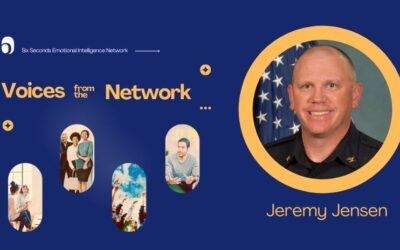Requesting Trust: 5 Practical Steps to Repair and Increase Trust
Want to increase trust with someone? Try this challenging-but-rewarding framework for talking about it
By Joshua Freedman – January, 2015, revised in October, 2019

Once you’ve identified the value of trust, assessed that you need to increase it, and focused on earning trust with the Four Cs – how do you go further?
Recap of last two posts in the Vital Signs Trust series:
One of the most important Vital Signs of a healthy climate is TRUST. When your people trust you, they dig deeper, listen better, and forgive more readily. When trust is low, there is more resistance, more fear, and communication doesn’t work as well (because people don’t believe each other). So the first article in this series discussed paying attention to and assessing trust as a two-way street, and using your feelings of distrust as a “barometer” to measure how others trust you. Then I went over the Trust Cs and how to make them more visible.
In this final Vital Signs of Trust series, you’ll learn a challenging-but-powerful process called the Trust Alliance.
The Ingredients of Trust
Before this technique will work, it helps to recognize that your feeling of broken trust is tied to fear. Fear is a helpful, insightful emotion that says, “Hey, I’m concerned! This could be dangerous.” The sense of danger could come because one of the “Trust C’s” (Caring, Commitment, Consistency, and Competence) are at risk:
- Commitment – You’re afraid they won’t follow-through.
- Caring – You’re afraid they don’t really care.
- Consistency – You’re afraid they’ll “explode” at someone.
- Competence – You’re afraid they’re not skilled enough to succeed.
Prepare to practice this technique by selecting a person with whom you have a small breach of trust — someone you value and who values you, someone with whom you can practice having a challenging conversation. Don’t start with someone you don’t trust — start with someone where you have trust and you’d like to “take it up a notch.”
How To Talk About Trust
The Trust Alliance is a conversation where you agree to support one another to increase mutual trust. The conversation has a few steps:
- Agree to talk about improving trust.
- Each person identify one way trust has been reduced (one thing the other person did or didn’t do).
- Each person identify one action to take to remedy the issue / increase trust.
- Agree to take the action, and support each other by identifying when it is done (or not).
- Appreciate the importance of this relationship.
Below, you can see an example of how someone might follow the steps. By practicing the process you’ll learn a lot about trust and building trust. You might then use a similar process with other employees and colleagues.
Trust Alliance a process we use in training once we’ve got a group seriously committed to increasing the quality of their team. It was adapted from work by wonderful educator in Mexico named Angelica Olvera.
Your Trust Alliance conversation might go something like this:
1. Agree to talk about improving trust.
You: “Carol, I had a realization about our relationship, and I want your help. I realized that the trust between us is not as strong as I’d like it to be, and I’d like to take responsibility for improving that. Would you be willing to discuss this with me?”
Carol: “Well you know I do trust you… our relationship is great!”
You: “Carol, it is great or I wouldn’t be asking you this! And it could be greater — would you be willing to try an experiment with me to see if we can increase our trust?”
Carol: “Sure, of course.”
2. Identify how trust has been reduced.
You: “Ok — here’s the process. I’d like us each to say one time when we felt trust diminish a little with the other person. Then we’ll decide on an action to turn that around.
I’ll go first: I was thinking about the interaction we had about — and in that situation I didn’t fully trust you.”
Carol: “Well, I don’t know if I’d use such a strong term, but I guess I know what you mean.”
You: “I think I was not fully trusting you because I was not totally sure how much you really cared in that situation. I would like to be more confident about that, and I just felt a tiny bit let down. Now your turn — what’s one action I’ve taken recently that may have reduced your trust in me?”
Carol: “Well — ok, I guess I can see that. It’s hard to think of something, but I guess …” (she gives an example)
You: “Thank you for telling me — I really appreciate the honest.”
3. and 4. Identify ways to increase trust and agree to take action
You: “Ok, so now I want us each to think of what the other person can do to improve in this area. My request to you is that you show how much you care by checking in with me more and just noticing when I’m wound up — do you know what I mean?”
Carol: “Yah, I know — I get caught up in the ‘go, go, go,’ sometimes. Yes — I can do that more.”
You: “Ok — now what can I do…”
5. Appreciate the importance of this relationship.
You: “Well just having this conversation I’m feeling we’re even more on the same page! I really value that we have this kind of honest relationship….”
Trust Building in Real Life
As you’ll experience if you’ve tried the exercises in this series on trust, developing trust is both highly challenging and incredibly rewarding. Just focusing on this topic and remembering it’s an essential part of your leadership responsibility can change the way you relate to team members.
Often “trust building exercises” are done away from work (in a classroom or on a ropes course). Instead, I suggest you’ll get a far greater benefit by taking that eight hours and spreading it out to a few minutes a week in the midst of your day-to-day work. Continuously work to assess, earn, and request trust — and let me know the results after 90 days!
Vital Signs Trust series:
Assessing Trust: How do you diagnose a relationship by checking your current level of trust?
Earning Trust: If you want to increase trust, what do you focus on?
Requesting Trust: When you want to take trust to the next level, how do you talk about it?
What’s new in emotional intelligence?
Emotional Intelligence at Work: The Free, Easy Win Most Managers Are Missing
Gallup study compares the biggest gaps in employee vs. manager perceptions. What are managers’ worst blind spots? What are easy wins they could do better to improve team performance?
Is Boredom Bad for Kids? Emotional Intelligence Education News
Let’s unpack boredom and how emotional intelligence can help you with tips to support bored children (and keep your cool!). Keep reading for EQ research and resources you can use for you, your faculty and students.
Effective Emotional Intelligence Coaching: 4 Questions to Improve Client Outcomes with Social and Cultural Insights on Emotions
Improve your emotional intelligence coaching by understanding the social and cultural influences on emotions. Ask these 4 key questions for more effective client relationships
Krish and Anabel: SEL Pioneer and Mentee Share 6 Life Lessons on Empathy, Integrity, and Emotional Intelligence
What are 6 life lessons you’ve learned? Dr. Anabel Jensen, SEL pioneer and Six Seconds President, explores this important question with her 16-year-old mentee.
Voices from the Network: Jeremy Jensen
In this Voices from the Network, we sit down with Police Chief Jeremy Jensen, who is doing emotional intelligence training with his officers in Dubuque, Iowa.
Emotional Intelligence at Work: Is There Hope for Toxic Workplaces?
The remarkable transformation at Westcomm Pump offers a blueprint for turning around workplaces with depleted morale and trust issues, using the Team Vital Signs assessment.
- Coaching Through the Emotional Recession: Three Practical Tips for Trauma-Informed Coaching - May 1, 2024
- Knowing Isn’t Coaching: Three Emotional Intelligence Tools for Professional Coaches - April 3, 2024
- Coaching Down the Escalator: 3 Emotional Intelligence Tips forCoaches to Reduce Volatility & De-escalate Conflict in a Polarized World - March 6, 2024







Great articles as always! You are missing step 3.
Hi Josh
i love the Trust alliance
simple, makes sense and i definitely can i’m prove my trust concerns ??????
Hi Josh, I really like the “Trust Alliance” exercise, I have used it in the past and I found it really powerful. thank you for sharing